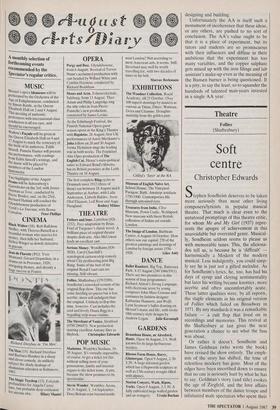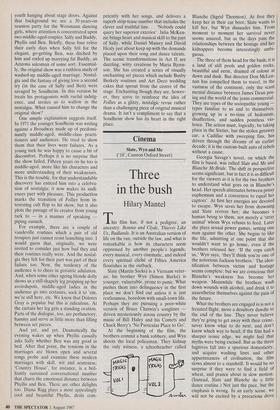Theatre
Follies (Shaftesbury)
Soft
centre
Christopher Edwards
Stephen Sondheim deserves to be taken more seriously than most other living composers/lyricists in popular musical theatre. That much is clear even to the untutored promptings of this theatre critic, for whom Me and My Girl (1937) repre- sents the apogee of achievement in this unavoidable but overrated genre. Musical- ly, Sondheim seldom seems to please us with memorable tunes. This, the aficiona- dos tell us, is because he is 'difficult' harmonically a Modern of the modern musical. Less indulgently, you could simp- ly say he is just not a gifted melodist. As for Sondheim's lyrics, he, too, has had his days of syrup and cloying sentimentality but later his writing became knottier, more acerbic and often uncomfortably acute. These latter qualities were, by all reports, the staple elements in his original version of Follies which failed on Broadway in 1971. By any standards it was a remarkable failure — a cult flop that lived on in recordings and memories. This revival at the Shaftesbury at last gives the next generation a chance to see what the fuss was about.
Or rather it doesn't. Sondheim and James Goldman (who wrote the book) have revised the show entirely. The emph- asis of the story has shifted, the tone of relentless mockery has gone. Most of the edges have been smoothed down to ensure that no one is seriously hurt by what he has to say. Goldman's story (and title) evokes the age of Ziegfeld, and the love affairs between members of the dance troupe and infatuated male spectators who spent their youth hanging about stage doors. Against that background we see a 30-years-on reunion party for the Weismann dancing girls, where attention is concentrated upon two middle-aged couples: Sally and Buddy, Phyllis and Ben. Briefly, these four relive their early days when Sally fell for the elegant, go-getting Ben, was ditched by him and ended up marrying fat Buddy, an Arizona salesman of some sort. Essential- ly, the original show was a ruthless study of washed-up middle-aged marriage. Nostal- gia and the fantasy of giving love a second try (in the case of Sally and Ben) were savaged by Sondheim. In this version he treats his protagonists with rueful indulg- ence, and invites us to wallow in the nostalgia. What caused him to change the original show?
One simple explanation suggests itself. In 1971 the younger Sondheim was writing against a Broadway made up of predomi- nantly middle-aged, middle-class practi- tioners and audiences. He tried to show them that their lives were failures. As a young turk he was happy to cause a bit of discomfort. Perhaps it is no surprise that the show failed. Fifteen years on he too is middle-aged, more like his characters and more understanding of their weaknesses. This is the trouble, for that understandable discovery has enticed him into a celebra- tion of nostalgia; it now makes its audi- ences purr with pleasure. This production marks the transition of Follies from in- teresting cult flop to hit show, but it also plots the passage of its creator from young turk to — in a manner of speaking piping eunuch.
For example, there are a couple of vaudeville routines which a pair of old troupers just cannot resist launching into. I would guess that, originally, we were invited to consider just how bad they and their routines really were. And the nostal- gia they felt for their part was part of their failure too. Now, the tendency of the audience is to cheer in geriatric adulation. And, when some other ageing blonde dolly shows us a still-shapely leg propping up her avoirdupois, middle-aged ladies in the audience go into ecstasies; sock it to 'em, we're still here, etc. We know that Dolores Gray is popular but this is ridiculous. At the curtain her leg gets a standing ovation. Parts of the dialogue, too, are perfunctory, hammy and serve as little more than filling between set pieces.
And yet, and yet. Dramatically the evening wakes up when Phyllis casually asks Sally whether Ben was any good in bed. After that point, the tensions in the marriages are blown open and several songs probe and examine these modern marriages with skill, wit and acuteness; `Country House', for instance, is a bril- liantly sustained conversational number that charts the emotional distance between Phyllis and Ben. There are other delights too. Diana Rigg plays a most appealingly cool and beautiful Phyllis, deals com-
petently with her songs, and delivers a superb strip-tease number that includes the clever and truthful line. . . 'Nobody could query her superior exterior'. Julia McKen- zie brings heart and musical skill to the part of Sally, while Daniel Massey and David Healy just about keep up with the demands placed upon their song and dance talents. The scenic transformations in Act II are dazzling, witty creations by Maria Bjorn- son. She has created a series of visually enchanting set pieces which include Busby Berkely routines and Art Deco wedding cakes that sprout from the centre of the stage. Enchanting though they are, howev- er, they serve to reinforce the idea of Follies as a glitzy, nostalgic revue rather than a challenging piece of original musical drama. It isn't a compliment to say that a Sondheim show has its heart in the right place.



















































 Previous page
Previous page